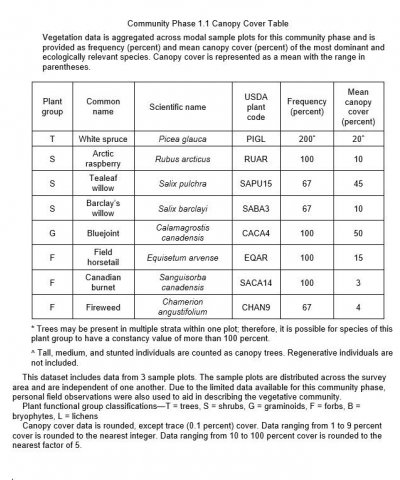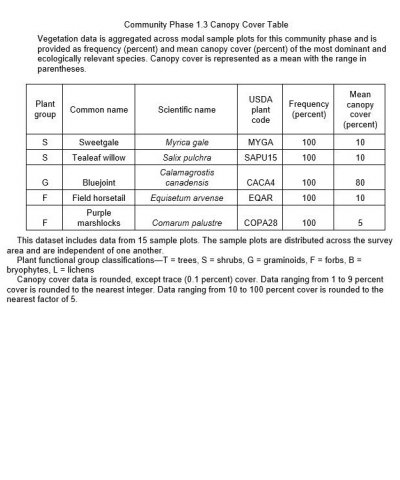

Natural Resources
Conservation Service
Ecological site F236XY176AK
Boreal Woodland Loamy Flood Plains
Last updated: 2/13/2024
Accessed: 12/22/2024
General information
Provisional. A provisional ecological site description has undergone quality control and quality assurance review. It contains a working state and transition model and enough information to identify the ecological site.
MLRA notes
Major Land Resource Area (MLRA): 236X–Bristol Bay-Northern Alaska Peninsula Lowlands
The Bristol Bay-Northern Alaska Peninsula Lowland Major Land Resource Area (MLRA 236) is located in Western Alaska. This MLRA covers approximately 19,500 square miles and is defined by an expanse of nearly level to rolling lowlands, uplands and low to moderate hills bordered by long, mountain footslopes. Major rivers include the Egegik, Mulchatna, Naknek, Nushagak, and Wood River. MLRA 236 is in the zone of discontinuous permafrost. It is primarily in areas with finer textured soils on terraces, rolling uplands and footslopes. This MLRA was glaciated during the early to middle Pleistocene. Moraine and glaciofluvial deposits cover around sixty percent of the MLRA. Alluvium and coastal deposits make up a large portion of the remaining area (Kautz et al., 2012; USDA, 2006).
Climate patterns across this MLRA shift as one moves away from the coast. A maritime climate is prominent along the coast, while continental weather, commonly associated with Interior Alaska, is more influential inland. Across the MLRA, summers are general short and warm while winters are long and cold. Mean annual precipitation is 13 to 50 inches, with increased precipitation at higher elevations and areas away from the coast. Mean annual temperatures is between 30 and 36 degrees F (USDA, 2006).
The Bristol Bay-Northern Alaska Peninsula MLRA is principally undeveloped wilderness. Federally managed land includes parts of the Katmai and Aniakchak National Parks, and the Alaska Peninsula, Becharof, Togiak and Alaska Maritime National Wildlife Refuges. The MLRA is sparsely populated. Principal communities include Dillingham, Naknek, and King Salmon. Commercial fishing in Bristol Bay and the Bering Sea comprises a major part of economic activity in the MLRA. Other land uses include subsistence activities (fishing, hunting, and gathering) and sport hunting and fishing (USDA, 2006).
Ecological site concept
This ecological site is on flood plain talfs of smaller tributary creeks. Site elevation is between 30 and 980 feet above sea level. Slopes are nearly level (0 – 3 percent). Soil hydrology, flooding, and a fire regime shape the vegetation on this site. A shallow water table and aquic soil conditions below 17 inches limit the number of white spruce on this site and create a woodland canopy rather than a forest. Wet soil is also reflected in the facultative to facultative wet wetland species found in the understory.
Local site factors including soil and site hydrology and flooding and fire disturbances support five communities in the reference stateThe reference state supports five communities. The reference plant community is characterized as a coniferous woodland (Viereck et al., 1992). It is composed of a white spruce canopy with an open understory of facultative to obligate wetland shrub, forb, and graminoid species. The relatively small size of this site along smaller tributaries make it susceptible to surrounding fires. Fires are more likely to occur in drier areas of this site where standing and dead trees and shrubs provide the most fuel. Post-fire vegetation is comprised of fast growing herbaceous species and extant shrubs.
Associated sites
| R236XY144AK |
Subarctic Scrub Peat Terraces R236XY144AK describes shrubland terraces in valleys. These terraces are supported on wet soils found alongside and at slightly higher elevations within a valley than the forested flood plains described by F236XY176AK. |
|---|---|
| F236XY139AK |
Boreal Woodland Loamy Rises F236XY139AK describes a boreal woodland on plains. These landforms slope down and abut the flood plains described by this site. |
| R236XY173AK |
Subarctic Riparian Complex Loamy Flood Plains R236XY173AK describes a rangeland on narrow valley flood plains. Occasional, long flooding events prevent a forest from developing on this site. |
Similar sites
| F236XY139AK |
Boreal Woodland Loamy Rises F236XY139AK describes a boreal woodland on plains. The forested reference plant communities on these sites are similar. However, site and soil differences result in different understory communities and different disturbance regimes. |
|---|
Table 1. Dominant plant species
| Tree |
(1) Picea glauca |
|---|---|
| Shrub |
(1) Salix pulchra |
| Herbaceous |
(1) Calamagrostis canadensis |
Click on box and path labels to scroll to the respective text.
Ecosystem states
State 1 submodel, plant communities
Communities 1 and 5 (additional pathways)
| 1.1A | - | Increased hydrologic pressures |
|---|---|---|
| 1.1B | - | Fire |
| 1.2A | - | Decreased hydrologic pressure |
| 1.2B | - | Increased hydrologic pressure |
| 1.3A | - | Decreased hydrologic pressure |
| 1.4A | - | Fire recovery. |
| 1.5A | - | Fire recovery. |







